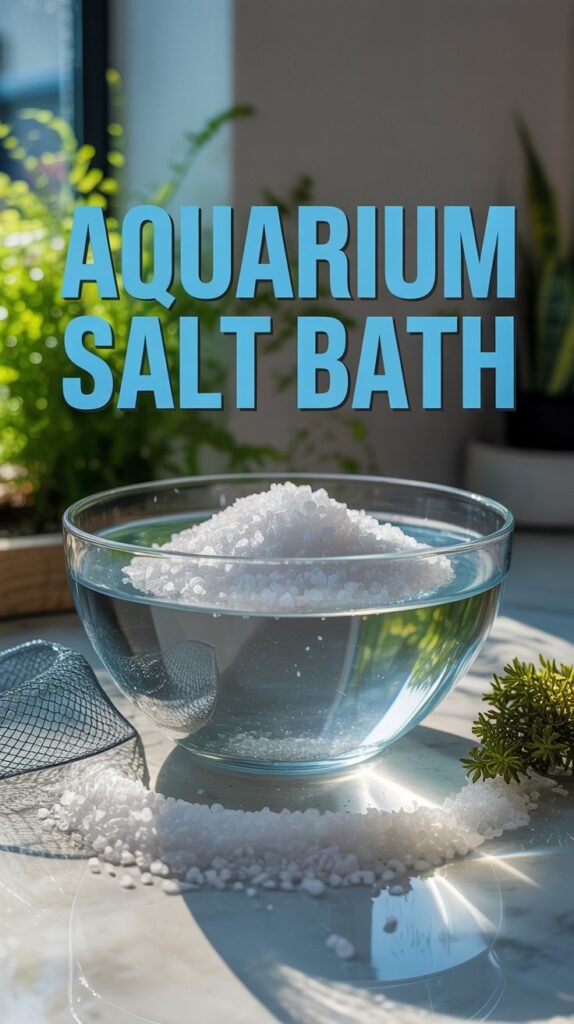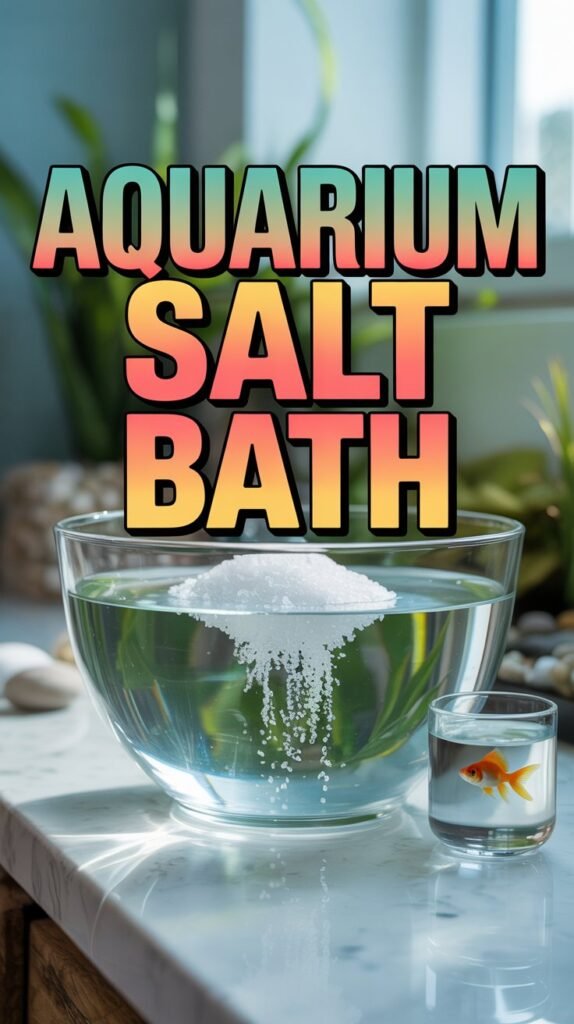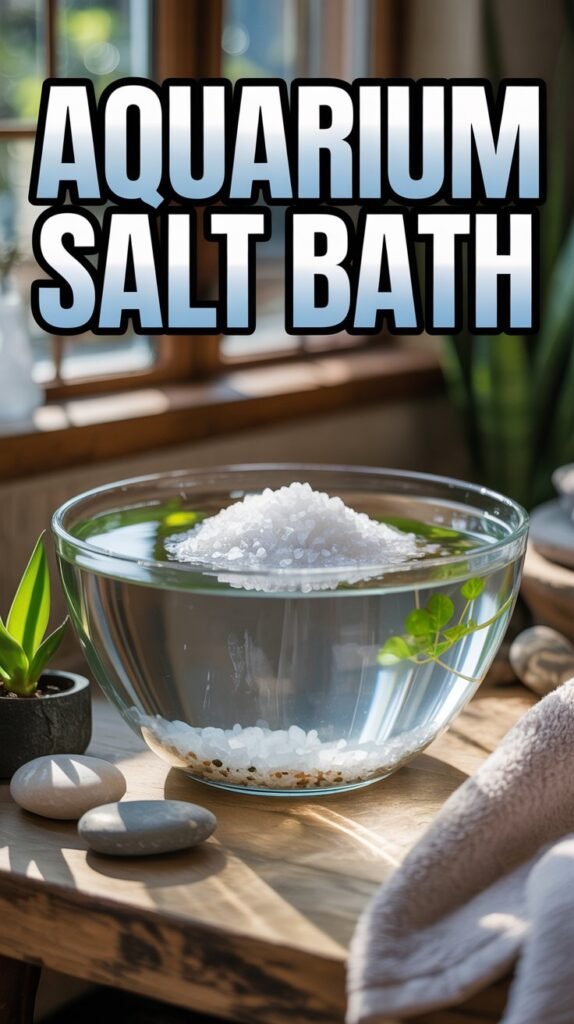When your fish show signs of stress, parasites, or infections, an aquarium salt bath can be one of the most effective, natural, and affordable treatments available. Salt baths have been used by aquarists for decades to help fish recover from diseases, boost immunity, and improve overall health. However, using salt incorrectly can do more harm than good.
In this complete guide, we’ll explain what an aquarium salt bath is, how it works, the right dosage and procedure, which fish can tolerate it, and when to avoid it. Whether you’re dealing with fin rot, ich, or stress-related issues, this article will teach you how to safely and effectively perform a salt bath for your aquarium fish.
What Is an Aquarium Salt Bath?
An aquarium salt bath is a temporary treatment method where fish are placed in a separate container containing saltwater of a specific concentration for a short period. It is primarily used to remove external parasites, heal fungal or bacterial infections, and reduce osmotic stress in fish.
The salt used is aquarium salt, not table salt or marine salt mix. It’s a purified form of sodium chloride (NaCl) free from additives or iodine that could harm fish.
Why Use an Aquarium Salt Bath?

Aquarium salt has many therapeutic benefits when used correctly. It’s a gentle and natural remedy for a variety of freshwater fish problems.
Key Benefits of Salt Baths:
- Kills Parasites: Salt interferes with the osmotic balance of external parasites, causing them to dehydrate and die.
- Reduces Stress: Helps fish regulate internal fluids during stress or disease.
- Improves Gill Function: Assists with oxygen uptake and reduces inflammation.
- Promotes Healing: Encourages recovery from wounds, fin rot, and ulcers.
- Fights Fungal & Bacterial Infections: Salt has mild antiseptic properties.
- Detoxifies Nitrite: Helps fish cope with nitrite poisoning in emergencies.
Note: A salt bath is different from adding salt directly to your main aquarium. It’s a short-term, high-concentration treatment performed outside the main tank to avoid harming other fish or plants.
The Science Behind Aquarium Salt Baths
Salt affects fish and parasites through osmosis, the natural movement of water through a semi-permeable membrane. Freshwater fish constantly absorb water through their skin and gills because their internal salt concentration is higher than their environment.
When placed in a mild saline solution:
- Fish lose some internal water, helping relieve stress and swelling.
- Parasites and pathogens, unable to regulate osmotic pressure, dehydrate and die.
This makes salt baths a powerful, low-chemical alternative to medications for mild infections or early disease stages.
Choosing the Right Type of Salt

Not all salts are safe for aquarium use. Using the wrong kind can harm or even kill your fish.
Safe Options
- Aquarium Salt (Freshwater Salt): Specifically made for aquarium use. It’s pure sodium chloride without additives.
- Kosher Salt or Rock Salt: Safe if free from iodine, anti-caking agents, or other chemicals.
Avoid These
- Table Salt: Often contains iodine and anti-caking agents.
- Epsom Salt (Magnesium Sulfate): Used for swelling, not general salt baths.
- Marine Salt Mix: Designed for marine tanks and contains minerals unsuitable for freshwater baths.
Always read labels carefully—purity matters most.
When to Use an Aquarium Salt Bath
Salt baths can help in many freshwater fish conditions, but timing and diagnosis are crucial. Here are the most common uses:
1. External Parasites
- Treats Ich (White Spot Disease), Velvet, Flukes, and Anchor Worms.
- Salt disrupts the parasite’s life cycle and provides relief to the fish.
2. Bacterial and Fungal Infections
- Effective against fin rot, columnaris, fungal spots, and body slime.
- Salt promotes healing and reduces bacterial load on the skin.
3. Stress Recovery
- Helps fish recover from transport stress, ammonia spikes, or water parameter fluctuations.
4. Nitrite Poisoning
- Chloride ions in salt help block nitrite uptake at the gills, reducing toxicity.
5. Wound Healing
- Speeds up tissue regeneration and prevents secondary infections in injured fish.
When NOT to Use an Aquarium Salt Bath
Salt baths aren’t suitable for every situation or species. Some fish are sensitive to salt, and overuse can cause osmotic shock or gill damage.
Avoid or use caution with:
- Scaleless fish (e.g., Corydoras, Loaches, Plecos)
- Fry and baby fish
- Salt-sensitive species (Tetras, Catfish)
- Heavily planted aquariums (if salt is added to the main tank)
Never use salt baths on weak or gasping fish, as the process can stress them further.
How to Prepare an Aquarium Salt Bath
Performing a salt bath correctly ensures your fish benefit without unnecessary stress. Follow these precise steps:
🧂 Step 1: Gather Supplies
- Clean plastic bucket or container
- Aquarium salt
- Heater (optional, to match tank temperature)
- Thermometer
- Air stone or gentle aeration (optional)
- Dechlorinated water
🧮 Step 2: Determine the Salt Concentration

The dosage depends on the severity of the condition and fish tolerance.
Mild Treatment (General Health or Stress Relief):
- 1 tablespoon (15g) of salt per 3 gallons of water
- Duration: 15–20 minutes
Moderate Treatment (External Parasites or Mild Infections):
- 1 tablespoon per 2 gallons of water
- Duration: 10–15 minutes
Strong Treatment (Severe Parasite Infestation):
- 1 tablespoon per 1 gallon of water
- Duration: 5–8 minutes maximum
Note: Always start with a lower concentration, observe the fish’s reaction, and increase only if tolerated well.
🌡️ Step 3: Match Temperature and pH
- Use water from the main aquarium to match temperature and pH.
- Avoid sudden changes that could shock the fish.
🐟 Step 4: Add Salt and Mix
- Dissolve aquarium salt completely in the container before adding the fish.
- Never add undissolved salt directly to the water with fish inside.
⏱️ Step 5: Place the Fish in the Salt Bath
- Gently transfer the fish into the prepared salt bath using a net.
- Keep the fish under observation throughout the process.
- If the fish shows signs of distress (e.g., frantic swimming, rolling, gasping), remove it immediately.
🪣 Step 6: Duration of the Bath
- Typical duration: 5 to 20 minutes, depending on concentration and species.
- Longer exposure can cause osmotic stress or dehydration.
Step 7: Rinse and Return Fish
- After treatment, transfer the fish to a separate container with clean dechlorinated water to rinse off excess salt.
- Then return it to the main tank.
Frequency of Salt Baths
Salt baths are typically done once daily or every other day, depending on the fish’s condition.
- For mild issues: 1–2 baths per week
- For moderate issues: Daily baths for 3–5 days
- For severe parasites: Up to 7 consecutive days (with careful monitoring)
Avoid long-term use, as frequent exposure to salt can damage the fish’s slime coat.
Combining Salt Baths with Other Treatments
Salt baths can be safely combined with other treatments under the right conditions.
Safe Combinations:
- Antibiotics (in main tank) for bacterial infections
- Temperature increase (for Ich treatment)
- Aquarium salt in main tank (low dose) for mild support
Unsafe Combinations:
- Copper-based medications
- Strong chemicals or formalin
- Salt plus high temperature for sensitive fish
Always research compatibility before mixing treatments.
Monitoring Fish During a Salt Bath
Observation is key during the entire process. Watch for these signs:
| Safe Signs | Danger Signs (Remove Immediately) |
|---|---|
| Calm swimming | Erratic, frantic movement |
| Steady breathing | Gasping for air |
| Normal color | Pale or darkened coloration |
| Relaxed behavior after bath | Loss of balance or rolling |
If the fish exhibits any danger signs, remove it immediately and place it in clean, untreated water.
Post-Bath Care
After a salt bath, your fish may feel temporarily disoriented but should recover quickly.
Post-treatment steps:
- Keep the fish in a quarantine tank for observation.
- Maintain excellent water quality (zero ammonia/nitrite).
- Provide a balanced diet to boost immunity.
- Add a small dose of aquarium salt (1 tbsp per 5 gallons) in the quarantine tank for mild ongoing support.
Aquarium Salt Bath for Specific Conditions
1. Ich (White Spot Disease)
- Concentration: 1 tbsp per 1 gallon
- Duration: 5–8 minutes
- Frequency: Once daily for 5–7 days
2. Fin Rot or Fungus
- Concentration: 1 tbsp per 2 gallons
- Duration: 10–15 minutes
- Frequency: Daily until fins show recovery
3. Bacterial Infections
- Concentration: 1 tbsp per 3 gallons
- Duration: 15–20 minutes
- Combine with antibiotics if needed.
4. Nitrite Poisoning
- Add salt directly to main tank (1 tbsp per 5 gallons) to reduce toxicity.
Salt baths help stabilize fish suffering from nitrite stress.
Safety Precautions and Tips
- Always use aquarium salt, not table or Epsom salt.
- Never pour salt directly into the bath while the fish is inside.
- Match temperature and pH between bath and tank water.
- Supervise continuously — never leave fish unattended.
- Start with mild doses and increase gradually if tolerated.
- Avoid prolonged exposure — 5–20 minutes is sufficient.
- Use fresh solution each time; don’t reuse bath water.
- Do not overuse salt baths; limit to necessary cases only.
- Monitor after each session for any behavioral changes.
- Consult a vet or aquarist if infection persists after multiple treatments.
Common Mistakes to Avoid
| Mistake | Why It’s a Problem |
|---|---|
| Using table salt | Contains iodine and anti-caking agents toxic to fish |
| Not dissolving salt fully | Undissolved crystals can burn fish skin |
| Too long bath duration | Leads to dehydration and stress |
| Using same bath multiple times | Bacteria buildup and contamination risk |
| Ignoring temperature | Sudden shock can kill fish instantly |
Avoiding these mistakes ensures effective and safe salt bath treatments.
The Role of Aquarium Salt in General Fish Care
Beyond baths, aquarium salt can also be used in low doses in the main tank to support fish health, especially for livebearers like guppies, mollies, and platies.
Benefits of Adding Small Amounts of Salt to the Main Tank:
- Enhances slime coat protection
- Reduces nitrite toxicity
- Aids in parasite prevention
- Promotes osmoregulation in brackish species
Recommended dosage for ongoing support:
1 tablespoon per 5 gallons of water (use only for salt-tolerant fish).
Case Study: Treating Ich in a Community Aquarium
Scenario: A 40-gallon tank with guppies and tetras developed Ich.
Solution:
- Removed all infected fish to a hospital tank.
- Prepared a salt bath (1 tbsp per gallon) for 7 minutes daily.
- Increased tank temperature to 82°F (28°C) to speed parasite life cycle.
- Performed 25% water changes daily.
- Within 5 days, white spots disappeared.
Result: Complete recovery with zero medication side effects.
This demonstrates the power of salt baths as a natural, safe, and effective treatment when done correctly.
Conclusion
An aquarium salt bath is one of the most valuable natural treatments every fishkeeper should know. When performed properly, it can save fish from infections, parasites, and stress — without resorting to harsh chemicals.
Always remember:
- Use only aquarium salt.
- Match water conditions carefully.
- Supervise your fish closely.
- Don’t overdo it — moderation is key.
A well-executed salt bath can make the difference between life and death for a sick fish. Used responsibly, it’s one of the simplest yet most effective tools in your aquarium care arsenal.
FAQs About Aquarium Salt Baths
Q1. What type of salt should I use for aquarium salt baths?
Use aquarium salt specifically made for fish. Avoid table salt, marine salt mix, or Epsom salt unless prescribed for specific conditions.
Q2. How often should I give my fish a salt bath?
Once daily or every other day, depending on the severity of the condition. Avoid prolonged or excessive use.
Q3. How long should a salt bath last?
Typically 5–20 minutes based on concentration and fish type. Stop immediately if fish show distress.
Q4. Can I reuse the same salt bath water?
No, always prepare a fresh solution for each session to prevent bacterial contamination.
Q5. Are salt baths safe for all fish?
No. Avoid using on scaleless fish (like loaches and catfish) and fry, as they are salt-sensitive.
Q6. What happens if I use too much salt?
Overdosing can cause dehydration, gill damage, or even death. Always measure carefully.
Q7. Can I combine salt baths with medications?
Yes, but only with compatible treatments. Avoid using with copper or formalin-based medications.
Q8. Do salt baths cure internal diseases?
No. Salt baths are effective for external parasites and infections, not internal diseases.
Q9. Can I perform salt baths on marine fish?
Marine fish already live in salty environments, so freshwater dips (reverse of salt baths) are used instead for marine species.
Q10. Is aquarium salt necessary for all freshwater tanks?
No. Many fish thrive without salt. Use it only when needed or for species that prefer slightly brackish conditions.

